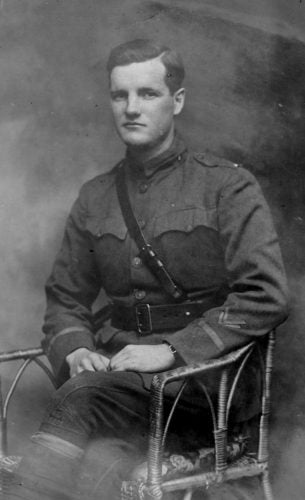- Colonel
- WW I
Biography
Harold P. Gibson was born on 4 August 1894 and grew up in Newport, Rhode Island. He was the oldest of three children of John and Mary Gibson. He graduated from Rogers High School, Newport, Rhode Island and entered Rhode Island State College in September 1916 with the class of 1920. Harold participated in the Army ROTC Program while attending RISC during his freshman year. He was a member of Beta Psi fraternity and a member of the Beacon staff.
When the United States entered World War I, there were 562 male students enrolled at Rhode Island State College; 334 left to serve in WW I. Harold, like so many of his classmates, left college at the beginning of his sophomore year to enter the U.S. Army and began his officer training at Plattsburg, New York in August 1917. In January 1918, he received his commission as a Second Lieutenant of Infantry and immediately deployed to France. 2LT Gibson was initially assigned as an infantry platoon leader, Company C, 1st Battalion, 23rd Infantry Regiment, Second Infantry Division. He was involved in combat operations throughout his assignment. Lieutenant Gibson was recognized numerous times for his bravery and gallantry in combat.
The Commander of the American Expeditionary Forces cited in General Orders 88, dated 31 December 1918:
First Lieutenant Harold P. Gibson, Company C, 23th Infantry Regiment
During offensive operations on 3 October 1918, near St. Etienne-Aux-Armes, France, Lieutenant Gibson displayed extreme bravery and total disregard of danger by rendering aid to wounded soldiers. In the attack on 4 October 1918, near Etienne-Aux-Armes, France, he led his company in an assault upon a strongly wired machine gun emplacement, behaving with extraordinary courage and coolness until severely wounded. He was decorated with the Croix de Guerre with Silver Star for bravery.
The Second Infantry Division went on to win hard-fought victories at Soissons and Blanc Mont. Finally, the “Indianhead” Division participated in the Meuse-Argonne Offensive which ended any German hope for victory. On 11 November 1918, the Armistice was declared; and the Second Infantry Division marched into Germany where it assumed occupation duties until April 1919.
Upon his return from France, Captain Gibson was assigned to the U.S. Army Infantry School, Fort Benning, Georgia to attend the Infantry Officers’ Course. After graduation, he was assigned to Schofield Barracks, Hawaii for three years performing company grade assignments. His next assignment was to attend the U.S. Army Command and General Staff College (CGSC), Fort Leavenworth, Kansas beginning September 1932. Upon completion of CGSC, Major Gibson was assigned as a student at the University of Iowa, Iowa City where he earned his Bachelor of Science Degree. He was than assigned as an Infantry Tactics Instructor at the United States Army Infantry School, Fort Benning, Georgia.
Shortly after war was declared on Japan and Germany in 1941, Lieutenant Colonel Gibson was once again thrust into battle in the defense of his nation. He deployed to Europe where he fought gallantly and was awarded the Silver Star and the Silver Star with Oak Leaf Cluster for bravery in combat. Colonel Gibson was severely wounded which resulted in a permanent disability. After he recovered from his wounds, he was assigned to Fort Belvoir, Virginia until his retirement from active duty on 31 January 1947. Colonel Gibson died suddenly in Alexandria, Virginia on 9 March 1956. He was buried with full military honors in Arlington National Cemetery.
Colonel Harold Pearson Gibson served our nation for 30 years leading, fighting, wounded and cited for bravery in both World War I and World War II. His exemplary devotion to duty, personal bravery and outstanding leadership is in the highest traditions of the military service and reflect great credit upon himself, his family and the University of Rhode Island.
Education
1920

